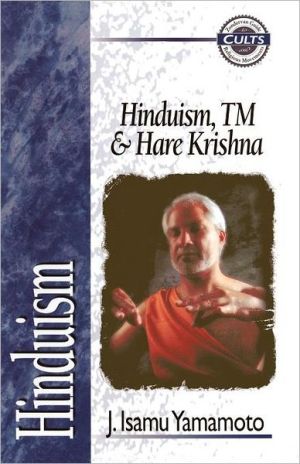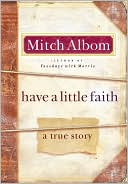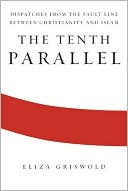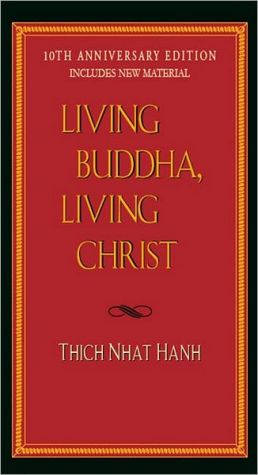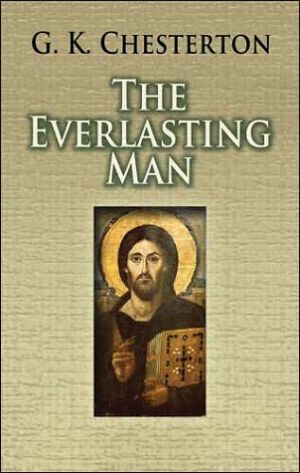Hinduism, TM and Hare Krishna
In the sixties, Transcendental Meditation, a Hindu-based movement, became fashionable as a way to therapy and psychological well-being — especially after being endorsed by the Beatles and the Beach Boys. Its influence waned, ironically, after the courts decided that TM was a religion rather than a form of therapy, as TM had claimed. But its popularity helped open the doors to a wider acceptance of Eastern philosophy and religions in mainstream America. Another Americanized form of Hinduism is...
Search in google:
This is one volume of a series of brief books on contemporary religious movements, comparing what they believe with Christian doctrine and explaining effective ways of witnessing to their adherents.
Hinduism, TM and Hare Krishna\ \ By J. Isamu Yamamoto \ Zondervan\ Copyright © 1998 Zondervan\ All right reserved.\ ISBN: 0-310-70391-3 \ \ \ \ Chapter One\ Part II: Theology\ I. Hindu View of History\ A. The Hindu Position on History Briefly Stated\ 1. The history of the world is eternally cyclical.\ 2. The gods revere a great serpent (Sesa), who sustains the world.\ 3. In the last of the four major ages (Kali Age), all of humanity will be completely destroyed.\ B. Arguments Used by Hindus to Support Their Position on History\ 1. The history of the world is eternally cyclical.\ a. Hindus measure time in accordance with the life of their creator god, Brahma.\ (1) The lifetime of Brahma is 12,000 divine years, with 360 human years being the length of one divine year. (2) According to Dimmitt and van Buitenen, "The universe endures as long as the god lives, then dies as he dies; a periodic dissolution of all forms coincides with the ending of Brahma's life."\ (3) Brahma is then born again from a cosmic egg and the cycle repeats and continues to repeat endlessly.\ b. The Puranas, Hindu sacred texts, divide time into four recurring ages (or yugas). (1) "In the first Age, the Krta, there was virtue; it continued throughout the Treta; becoming confused in the Dvapara, it is lost altogether in the Kali."\ (2) The length of each age is, for the Krta Yuga, 4,800 divine years; the Treta Yuga, 3,600 divine years; the Dvapara Yuga, 2,400 divine years; the Kali Yuga, 1,200 divine years.\ c. "The four Ages as a unit are understood to repeat in a continual and endless cycle."\ (1) Each age progressively decreases in length just as the world and humanity become increasingly evil and morally corrupt.\ (2) Hindu doctrine teaches that we are currently living in the Kali Age when humanity is at its worst.\ 2. The gods revere a great serpent (Sesa), who sustains the world. a. Sesa (pronounced SHA-shu) is lord of the snakes.\ (1) Although the worship of snakes is ancient in India, Sesa does not appear until the writing of the Mahabharata (c. 400 B.C.).\ (2) In Indian art Sesa is depicted as the thousand-headed serpent.\ b. Sesa means "remainder" in Sanskrit.\ (1) Hindu texts say that Sesa destroyed all the worlds at the end of the Kali Yuga with fire from his mouth.\ (2) After this cataclysmic destruction of the worlds, Sesa was created from the residue that was left-hence the meaning of his name.\ (3) He is also called Ananta, which means "endless."\ c. Sesa is associated with the three major Hindu gods.\ (1) According to Hindu myths, Sesa pleased the creator god Brahma with his piety, and thus Brahma accorded him the honor of bearing the earth.\ (a) While Sesa's serpentine coils encircle the earth, he carries the earth on his head.\ (b) Thus Sesa is regarded as the foundation of the earth.\ (2) Sesa is also said to be born of the destroyer god Siva, becoming the axle of his divine vehicle.\ (3) Sesa, however, is mostly linked with the sustainer god Visnu, who is often portrayed reclining on Sesa.\ d. In fact, Sesa is "revered by all the gods," having the characteristics of righteousness, peace, and asceticism.\ 3. In the last of the four major ages (Kali Age), all of humanity will be completely destroyed.\ a. By the end of each Kali Yuga, humanity degenerates to the depth of evil.\ (1) The current Kali Age began at the end of the Mahabharata war toward the close of the fourth millenium B.C., and it will last for more than 400,000 years longer from this present time.\ (2) Human greed is the root of human suffering, and this greed increasingly prevails in the Kali Age.\ (3) In addition, selfishness is the source of war, disease, and death.\ (4) Other characteristics of the Kali Age are that people will forget the Vedas; different social classes will mix with one another; and deceit, murder, and famine will become more common.\ (5) Hindus divide sins into three major categories, all of which become more prevalent in the Kali Age.\ (a) Violating social customs, such as dishonoring one's family and showing no respect to Brahmin priests.\ (b) Not maintaining purity of body, such as eating cow meat.\ (c) Committing evil behavior, such as stealing and killing.\ b. Decay of the world and humanity is a natural process, whose inevitable result is the destruction of creation.\ (1) After the earth becomes bare of vegetation because of increasing human perversions, all living beings physically die of starvation.\ (2) The sun then scorches the earth, drying it of all water. (3) The world is enflamed until a cosmic rain douses the fire and floods the entire earth.\ (4) As a result, nothing exists except for this cosmic ocean, which has absorbed the spiritual remains of created beings, who anticipate being reborn in the next creation.\ (5) Brahma's life comes to an end at the conclusion of the Kali Age, and then he is born again from this cosmic ocean, at which time Brahma creates the universe again.\ C. Refutation of Arguments Used by Hindus to Support Their Position on History\ 1. The Hindu concept of time is without scientific support and conflicts with historical scholarship.\ a. There is no evidence that the present creation has a life span of 4,320,000 years, as asserted by the Hindu sacred texts (Puranas).\ (1) Science can only guess as to the age of the universe. Therefore, science can neither confirm nor refute this Hindu figure.\ (2) No sacred literature independent of Hindu scriptures concurs with this assertion.\ b. The Hindu classification and description of the four ages is flawed in light of what is known of the ancient history of India.\ (1) According to the Puranas, the Vedas existed from the begin-ning of creation, and in the Kali Age, which began about five thousand years ago, people "are ignorant of the Vedas" and "recite the Vedas incorrectly."\ (2) Yet historians contend that the Aryans did not migrate into India before the third millennium B.C., and the Vedas emerged thereafter.\ (3) In the "General Introduction" to A Sourcebook in Indian Philosophy, which provides the texts and commentary to key Hindu scriptures, Hindu scholar Sarvepalli Radhakrishnan and Charles Moore stated, "The Vedic Period is dimmed by obscurity, but it may be placed approximately between 2500 and 600 B.C. This is the period during which the Aryans, having come down into India from central Asia, settled their new homeland and gradually expanded and developed their Aryan culture and civilization.... The literature of this period consists of the four Vedas (Rg Veda, Yajur Veda, Sama Veda, and Atharva Veda).... The Mantras [from these Vedas] ... constitute the actual beginning of Indian philosophy."\ c. The cyclical view of time is untenable and leads to human despair.\ (1) The transition from one creation cycle to the next is illogical since each cycle corresponds to the life cycle of the creator god Brahma.\ (a) If the life of the creator ends with the dissolution of his creation, then a greater force must have caused the rebirth of Brahma to create again.\ (b) And if that force can mastermind the same sequence of ages (the four yugas) within every cycle, as opposed to being subject to random chance, then this force must be intelligent.\ (c) Yet Hindu philosophy cannot logically explain what this intelligent force is and why it has designed something that goes forever in a circle but has no ultimate goal.\ (2) Also, believing that all things must continuously repeat this cycle inspires little, if any, hope for eternal joy and peace. (a) Even if we achieve union with Brahman and bliss-consciousness with Krisna, we must be created again in the next cycle and go through the same sequences of sin, suffering, death, rebirth, spiritual discipline, and self-realization.\ (b) If all things are absorbed in Brahman at the end of each cycle anyway, the desire for liberation from ignorance and the effort to achieve self-illumination diminishes further for most people.\ 2. The religious significance of Sesa is dubious and ominous.\ a. The Puranas' account of Sesa's destruction-creation roles is illogical.\ (1) On the one hand, the Puranas say that Sesa destroyed the worlds.\ (2) On the other hand, the Puranas say that Sesa was created from the "remains" of the worlds he destroyed.\ (3) It is argued that Sesa emerges from the residue of one cycle and then becomes the destroyer of the worlds in the next cycle.\ (4) The problem, however, is that then countless preexistent Sesas exist at the time of each of his creations, which is confounding unless Sesa also destroys himself at the time of dissolution.\ (5) The Hindu scriptures do not indicate that this occurred; in fact, the differing accounts of Sesa at the end and beginning of cycles make this possibility extremely ambiguous.\ b. The reverence given to the serpent is an affront to God and de-meaning to humanity.\ (1) Even within Hindu scriptures, Sesa the serpent is depicted as a created being.\ (2) Moreover, when the Hindus worship snakes, they are worshiping actual creatures.\ (3) That gods worship a created being is the same as saying the Creator worships the beast of the field.\ (4) In his explanation of Romans 1:25, biblical scholar James D. G. Dunn comments on this misdirected homage this way: "Paul points again to the root cause of humankind's corrupted and dishonoring state. They exchanged what they knew to be the truth of God for a lie; they preferred to direct their devotion to the creature instead of the Creator. Here the echo of Gen 3 is even stronger. Adam/man believed the serpent's calumny and deception ('You will not die ...; you will be like God' [Gen 3:4-5]). And the result? Not that he became independent and godlike, but rather that he became caught in a baser dependence, a dependence on things; he became less than human, the creature of creatures rather than of the Creator. As Paul himself implies so clearly, man the creature is bound by his very nature to worship and serve something beyond himself. So that if he rejects the only one worthy of his worship and service, it is inevitable that he will direct that basic drive toward an inferior object and thus reduce his own stature in consequence. Who would think to choose as one's master the created thing rather than the glorious Creator? But that is just what man has done."\ (5) The worship of the creature is folly to those who know the Creator.\ 3. The Hindu teaching on human evil and universal desolation is self-defeating.\ a. Although Hindu texts indicate that we are living in the last age when humanity has sunk to the depth of moral corruption, even revered Hindu teachers cannot proclaim such an unpleasant message to the world.\ (1) In fact, many gurus and swamis have come to the West, promoting harmony among all peoples by extolling the goodness of humanity.\ (2) For instance, Swami Vivekananda, founder of the Vedanta societies, declared at the first World Parliament of Religions in Chicago in 1893, "It's a sin to call a man a sinner."\ (3) Although Judeo-Christian doctrine teaches that all humanity is fallen and sinful, it also asserts that people can be delivered from this condition without their personal identity being lost in a cosmic ocean.\ b. Although Hindu scriptures predict that all humankind will be destroyed, Hindu leaders cannot admit to the hopelessness of this kind of fate for humanity.\ (1) Spiritual Hindu leaders have promised that worldwide compliance to their teachings will lead to a golden age for the human race.\ (2) For example, Maharishi Mahesh Yogi called this wonderful time the "Age of Enlightenment," as described in his book Transcendental Meditation.\ (3) Moreover, Maharishi founded the Spiritual Regeneration Movement in the late 1950s "with the sole purpose of spiritually regenerating the lives of all men in every part of the world" in order to usher in this "Age of Enlightenment."\ (4) Despite the efforts of all dedicated Hindus to create a time of universal peace and goodwill, they cannot dismiss their own scriptures that predict the total annihilation of the human race at the end of this Kali Yuga.\ (5) Christian doctrine also warns of a desolation to come, but those who follow Christ will be spared from eternal damnation and commune with the Lord Jesus forever, which gives believers an assured hope for future happiness.\ D. Arguments Used to Prove the Biblical Doctrine on History to Hindus\ 1. God is independent of time, which is not cyclical but linear.\ a. God is not bound to any life cycle.\ (1) Jesus said he and his heavenly Father existed before the creation of the world, for he prayed, "And now, Father, glorify me in your presence with the glory I had with you before the world began" (John 17:5).\ (2) Moreover, God the Father and his Son have always enjoyed a personal, loving relationship, as indicated in Jesus' words to God, "You loved me before the creation of the world" (v. 24).\ \ Continues...\ \ \ \ Excerpted from Hinduism, TM and Hare Krishna by J. Isamu Yamamoto Copyright © 1998 by Zondervan. Excerpted by permission.\ All rights reserved. No part of this excerpt may be reproduced or reprinted without permission in writing from the publisher.\ Excerpts are provided by Dial-A-Book Inc. solely for the personal use of visitors to this web site. \ \
How to Use This Book6IIntroduction7IITheology22IIIWitnessing Tips62IVSelected Bibliography77VParallel Comparison Chart82VIGlossary87
